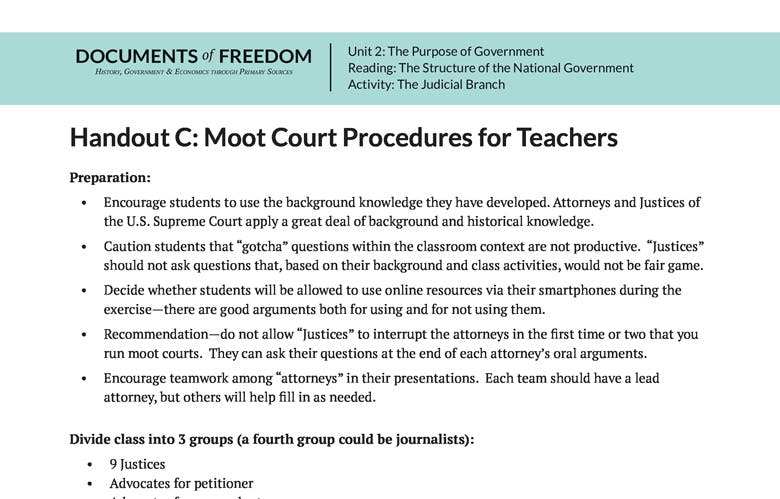Handout C: Moot Court Procedures for Teachers
Handout C: Moot Court Procedures for Teachers
Preparation:
- Encourage students to use the background knowledge they have developed. Attorneys and Justices of the U.S. Supreme Court apply a great deal of background and historical knowledge.
- Caution students that “gotcha” questions within the classroom context are not productive. “Justices” should not ask questions that, based on their background and class activities, would not be fair game.
- Decide whether students will be allowed to use online resources via their smartphones during the exercise—there are good arguments both for using and for not using them.
- Recommendation—do not allow “Justices” to interrupt the attorneys in the first time or two that you run moot courts. They can ask their questions at the end of each attorney’s oral arguments.
- Encourage teamwork among “attorneys” in their presentations. Each team should have a lead attorney, but others will help fill in as needed.
Divide class into 3 groups (a fourth group could be journalists):
- 9 Justices
- Advocates for petitioner
- Advocates for respondent
Procedure:
- Give time for planning: Justices decide what questions they want answered in oral arguments; advocates for each side plan their oral arguments.
- Allow equal time for presentation of each side, including interruptions from Justices (or not— your choice). In the U.S. Supreme Court, each side has 30 minutes, and the Justices interrupt continuously.
- Justices deliberate and announce decision. Deliberation is actually done in strict privacy in the U.S. Supreme Court conference, but you decide for your class.
- At the beginning of each session of the Supreme Court, the Marshal of the Court (Court Crier) announces:
“Oyez! Oyez! Oyez! All persons having business before the Honorable, the Supreme Court of the United States, are admonished to draw near and give their attention, for the Court is now sitting. God save the United States and this Honorable Court!”
The Chief Justice will begin the oral argument phase by saying, “Petitioner, you may begin.”
The petitioner’s attorney says, “Mr. Chief Justice, and may it please the Court…”
Debrief:
Discuss both the content of the case (constitutional principle employed. Consider thinking and planning process, civil discourse process, and the application of these skills outside the classroom. and its application) and the processes.
